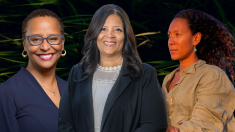We have all been regaled with stories about our slave ancestors escaping from the harsh life of the plantations in the South, finding their freedom in the North by "following the North Star" through alligator- and snake-infested swamps, hiding by day in dense forests, braving the elements, dangerous animals and disease-bearing mosquitos and eventually finding freedom across the Mason-Dixon Line, frequently guided by that courageous conductor on the Underground Railroad, Harriet Tubman. Few elements of African-American history have been more mythologized or misunderstood than the legendary Underground Railroad, and one of my columns during Black History Month will deal with that, as this series moves chronologically to antebellum America and the Civil War.
But the question for today is, "Where was the first Underground Railroad?" I think that the answer will surprise you, just as it surprised me when we filmed this story for my forthcoming PBS series, Many Rivers to Cross: The History of the African American People.
It stands to reason that slaves in the Southern states had to flee north to gain their freedom, following the metaphorical "drinking gourd" (as the Big Dipper was called), right? And this was certainly the case after 1830, when what we now call the Underground Railroad came into common usage in the press. So you will be forgiven if you think that this has always been true. Actually, the very first slaves in what is now the United States fled to their freedom by running south, not north.
How could this have been possible? The answer has to do with the early Colonial rivalry for territory, manpower and resources between Spain and England. As the historian Jane Landers outlines in a fascinating essay, "Southern Passage: The Forgotten Route to Freedom in Florida," that drama unfolded among Charleston, S.C., Savannah, Ga., and St. Augustine, Fla., in the late 1600s and the early 1700s.
The first African slaves are thought to have come to what is now the United States to help found San Miguel de Guadalupe, a settlement near Sapelo Sound, Ga., in 1526. A few decades later, in 1565, the Spanish founded St. Augustine, bringing with them perhaps some 50 African slaves. Just over a century later, Barbadian planters of English descent founded Charleston, which was "but 10 days journey" from St. Augustine. The New World rivalry between Colonial Spain and England was on.













